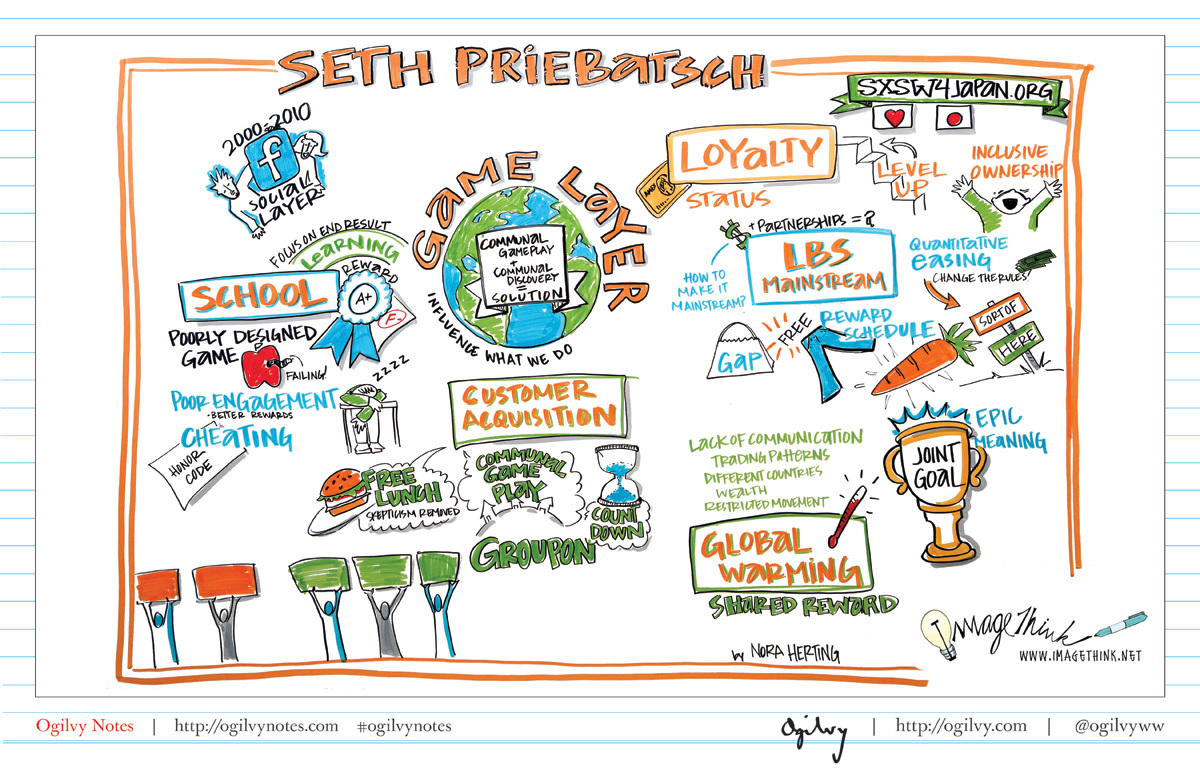One of the featured keynotes at South By South West Interactive (#SXSWi) was Seth Priebatsch, Chief Ninja of SCVNGR who announced that we have moved from the decade of the social layer to the decade of the game layer. As the conference continued, games, gamification, and gameful dynamics became the explanations of all online and offline actions.
So, amidst the most conceptually noisy conference in the country, I decided to create my own SXSWi game. Enjoy!
What's your startup again?
This is a great game if you've gone to SXSWi without a misspelled startup that leverages niche messaging and game dynamics.
Players: 3-5
Venue: Bar or party sponsored by venture capital firm
Goal: Be the first player to reach 11 points
Going first: The first person to check into the current venue with a location-based service app goes first.Round 1
Player 1 begins by coming up with a random internet startup URL. Tip: try personalizing the first inanimate object or action you can think of, swapping some vowels, and turning it into an adverb, e.g. MyCouch.ly, iDrynk.ly.Player 1 then asks the player to the right: "What's your startup again? Wasn't something like iDrynk.ly?" Using the startup name they just came up with in their head.
Player 2 must then immediately respond with a full business pitch of what the startup does, who it targets and how it will scale like Facebook, without laughing (if Player 2 laughs Player 1 gets a point). Once done, Player 2 comes up with a new startup URL and asks it as a question to Player 3.
Play continues until all players have pitched a startup. Then all members of the group give 0-3 points to each of the pitches based on creativity, scalability, hilarity, and whether they would invest as a venture capital firm.
Round 2
Player 1 describes a startup, what it does, who will use it, and how it will scale without giving the URL of the startup. The other players then makeup URLs for the described startup and Player 1 assigns points to each player from 0-3.Play continues until each player has described a startup and assigned points to the guesses of other players.
Next Round
Rounds continue, switching between round 1 and round 2 format until a player gets 11 points.Challenges
At anytime during the game, a player may challenge any URL another player creates if they think it is actually a real site. If the site exists, meaning it doesn't have a generic server not found or domain placeholder page, then the player that challenged gets 1 point and the player that was challenged loses 1 point. If the site does not exist, the accusing player loses 2 points and the game continues.
Two Dangers of SXSWi Thinking for Not-for-Profits
1. Redundancy
As this game is played many of the startup ideas that are created will end up being more unique than most of the startups showcasing at SXSWi. In general, their ideas rely on an already proven concept and then add a very slight twist to the platform with a sprinkling of game dynamics that they are convinced will make it "the next big thing."
Fortunately the redundancy that exists in the tech sector helps foster innovation and a climate that percolates the best ideas up. Unfortunately when this methodology is applied to the not-for-profit (NFP) sector it can result in redundancy that drains funding and resources from existing organizations that work.
SXSWi was ripe with tech that overlapped and probably should have been rolled into existing organizations. The NFP sector definitely needs fresh tech innovation, but it is not as simple as copying and pasting the Silicon Valley startup model. For example there is no startup that could displace the deep branding and community relationships of the Salvation Army, but I am sure that an agile group supported within the organization could incubate impact-driving innovation.
2. Games
Games are fun, which is good because they are about to be added to everything coming out of the tech sector and beyond. Whether it fits or not, pretty soon your toilet will be giving you a number 2 and letting you know how you did on the neighborhood leader board. There is tremendous potential to be released in Gameful design (gaming for social good) described by Jane Mcgonical, but it must be done intelligently.
The danger comes when our sector adds a game layer without considering the implications. Services that depend on game dynamics know that they have a fixed user lifespan as those dynamics wear off. This is one of the challenges facing location-based service apps (Gowalla and Foursquare), which made a splash at last year's SXSWi.
When unrelated game dynamics and incentives are added to social good actions, they can condition people to 'do good' for extrinsic rewards. Which begs the questions: What happens when we run out of larger rewards? And, what happens when the game dynamics wear off?